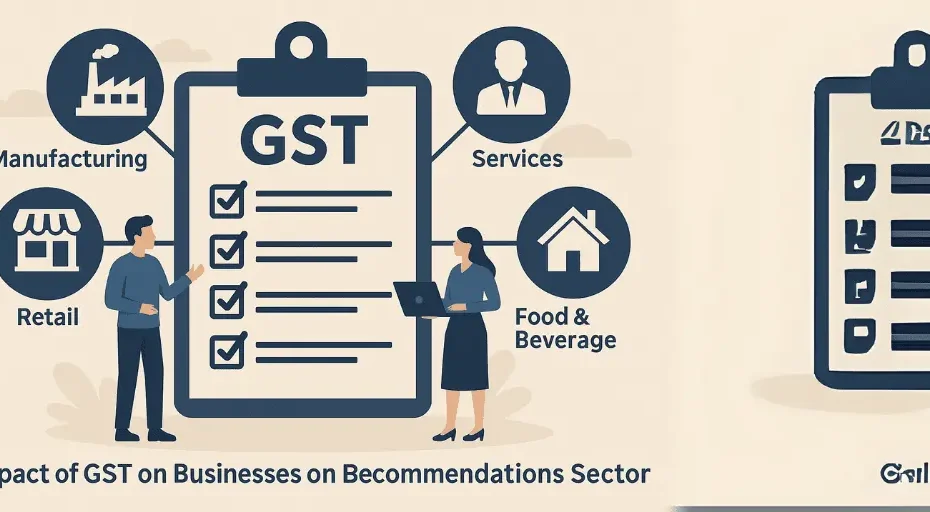Understanding the Wide-Ranging Impact of GST on Businesses After Council Recommendations
Introduction
The Goods and Services Tax (GST) regime has been a transformational shift in India’s indirect taxation system. Since its introduction, one of the most influential drivers of change under this system has been the GST Council—an apex decision-making body that determines tax rates, exemptions, and compliance measures. Its periodic recommendations have significantly shaped the impact of GST on businesses, both large and small, across various sectors.
In this blog, we take a sector-wise look at how the latest GST Council recommendations are influencing industries in terms of tax structure, compliance burden, and overall ease of doing business. By understanding the impact of GST on businesses, stakeholders can better align their strategies and operations to remain competitive and compliant.
1. Manufacturing Sector: Streamlining and Compliance Enhancement
The manufacturing sector, being one of the largest contributors to GDP, has witnessed notable changes due to GST. Previously plagued by cascading taxes, the GST regime brought relief through seamless input tax credit. However, the impact of GST on businesses in manufacturing continues to evolve with each council recommendation.
Recent decisions like rationalizing the tax slabs for raw materials and machinery, standardizing e-invoicing for medium enterprises, and stricter audit trails have forced manufacturers to invest in better digital infrastructure. This enhances long-term efficiency but increases short-term compliance costs.
For example, a recent GST Council recommendation included making e-invoicing mandatory for businesses with turnover above ₹5 crore. This measure improves transparency but adds a technological burden, especially for mid-sized manufacturers.
2. Retail Sector: A Mixed Bag of Relief and Challenges
Retailers, especially those in the FMCG and lifestyle segments, experience fluctuating effects of GST based on council interventions. The impact of GST on businesses in this sector is often immediate due to their proximity to the end consumer.
One of the major positives has been the reduction in GST rates on essentials and consumer durables, which boosts demand. Additionally, the simplification of return filing for small traders under the QRMP (Quarterly Return, Monthly Payment) scheme has brought procedural relief.
However, compliance remains a sore point. Frequent changes in rates and the necessity to match vendor filings in GSTR-2A/2B can lead to input tax credit mismatches. Retailers now rely heavily on GST-compliant supply chain software to avoid penalties and cash flow disruptions.
3. Services Sector: From Ambiguity to Structure
The services sector—ranging from IT to hospitality—initially faced ambiguity in interpreting GST norms. Over time, the impact of GST on businesses in this space has stabilized due to more targeted council recommendations.
For instance, the decision to exempt services provided by educational institutions and healthcare providers has offered relief to core sectors. Meanwhile, IT and consulting firms benefit from zero-rated exports, enabling them to claim refunds on input tax credits.
Yet, complexity persists. Changes in place-of-supply rules and reverse charge mechanisms have created compliance challenges. The Council’s move to unify tax rates across services is aimed at reducing classification disputes, ultimately improving clarity and compliance.
4. Real Estate & Construction: Increased Transparency, Lower Informality
The real estate sector, long criticized for its opacity, is witnessing increased transparency due to GST. The impact of GST on businesses in this domain is transformative, especially after the Council decided to impose 5% GST on under-construction properties without input tax credit.
While this measure curbed tax evasion, it also increased the cost for developers since they can’t claim credits on raw materials like cement and steel. On the buyer’s side, simplification and uniformity in tax have been beneficial.
Recent Council recommendations focusing on advance rulings and anti-profiteering provisions further ensure that developers don’t pocket tax benefits meant for consumers. However, more clarity is still needed around joint development agreements and TDR (Transfer of Development Rights).
5. Food & Beverage Industry: Sensitive to Rate Changes
This sector is extremely sensitive to any tax rate changes. The impact of GST on businesses here can be drastic because even a small rate hike can affect price-sensitive consumers.
Earlier GST Council meetings resulted in a standardization of rates—5% for restaurants without input tax credit and 18% with input tax credit for those in luxury or air-conditioned settings. This bifurcation affected pricing models and required a relook at cost structures.
Recent recommendations aimed at uniformity and input credit optimization are a welcome change. However, businesses in this sector are still calling for rationalization to reduce effective tax incidence without compromising profitability.
6. Textile Sector: From Informality to Organized Growth
Historically dominated by informal players, the textile sector has gradually become more organized under GST. The impact of GST on businesses in textiles was initially disruptive, especially for unregistered units facing credit chain issues.
The Council’s decision to include all textile products under GST net, regardless of value, was a turning point. While it disrupted the informal players, it pushed the industry toward better recordkeeping and digital compliance.
New council recommendations encouraging uniform tax rates across yarn, fabric, and garments are expected to further streamline operations. This could lead to better export competitiveness and growth in formal employment.
7. Logistics Sector: Gaining from Efficiency, Challenged by Tech
The logistics and transportation sector has arguably seen one of the most positive impacts of GST on businesses. The elimination of state check-posts due to the e-way bill system has drastically reduced transit time.
However, the Council’s increasing emphasis on digital tracking, real-time invoicing, and geo-tagging of warehouses introduces operational hurdles. Small logistics providers may struggle with adopting these technologies without proper support or training.
Recent GST Council recommendations, such as exempting certain essential goods from e-way bill requirements or raising thresholds, offer practical relief. But balancing efficiency with technology readiness remains a concern.
Conclusion
Across sectors, the impact of GST on businesses is a story of both disruption and opportunity. The GST Council plays a pivotal role in this narrative—its recommendations can redefine tax rates, compliance structures, and industry practices overnight.
For business owners, staying updated with these recommendations isn’t just a compliance necessity—it’s a strategic imperative. Investing in GST-ready systems, upskilling finance teams, and seeking expert advice can go a long way in leveraging the advantages while mitigating the challenges.
As India continues to fine-tune its GST framework, one thing is certain—the impact of GST on businesses will remain dynamic, demanding constant adaptability and resilience from all stakeholders.
Our GST Services

All E-commerce Tax services
E-commerce tax services help online sellers navigate GST registration, compliance, return filing, TCS management, tax planning, and audits, ensuring efficient tax management and legal compliance.

GST Filing
GST filing is the process of submitting tax returns to the government, detailing sales, purchases, and taxes paid or collected, ensuring compliance with GST laws.

GST Registration
GST registration is the process where businesses obtain a GSTIN from the government, allowing them to collect taxes, claim input tax credits, and comply with GST laws.





